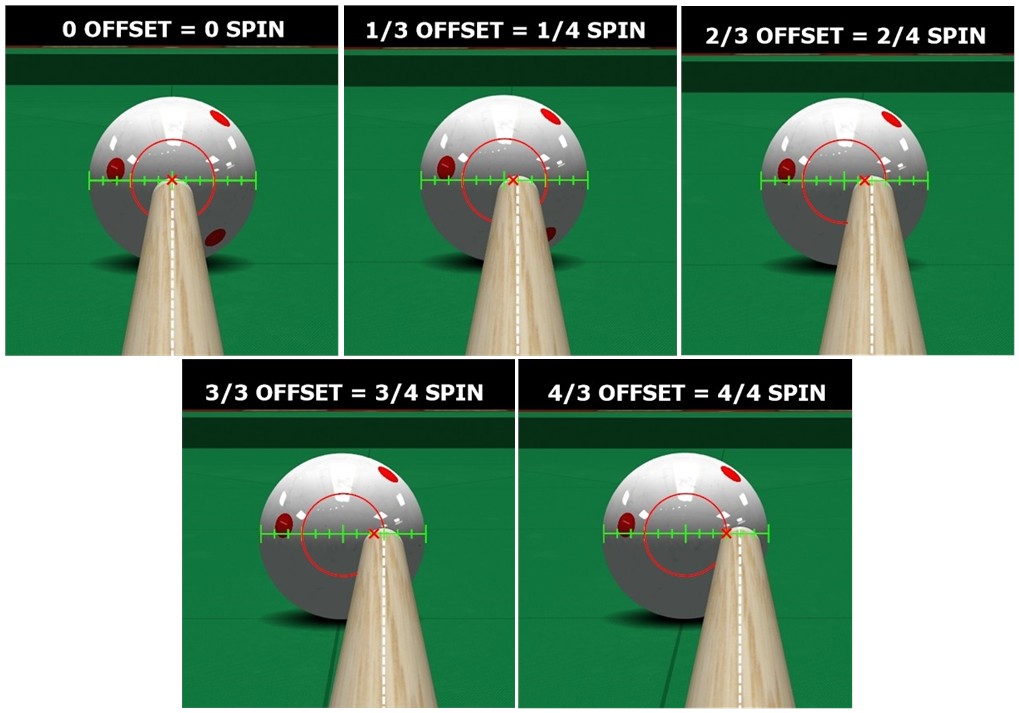What does it mean when somebody says “one tip of english,” and how is “percentage spin” defined?
“Squirt – Part VI: tip shape” (BD, January, 2008) and “Draw Shot Primer – Part VII: tips of english” (BD, July, 2006) illustrate and explain “tips” of spin or english. “One tip” of spin corresponds to shifting the cue one tip-width away from the center of the ball. Because the actual tip offset for “one tip” of spin depends on both the tip size and shape, I prefer specifying the amount of spin as a percentage instead (100% for maximum spin, 50% at half of maximum, etc.). Maximum spin is defined to be at the miscue limit, which corresponds to a tip contact point halfway to the edge of the CB. As shown below, this limit can be easily visualized with a striped ball because the width of the stripe is usually half the ball’s diameter.
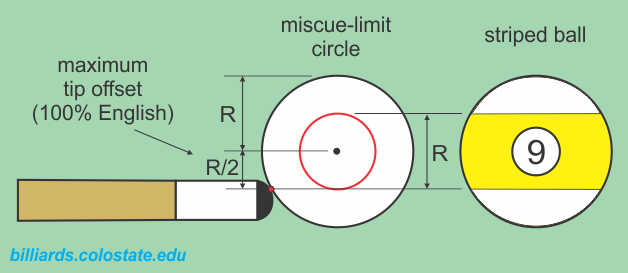
When describing the amount of sidespin only, “percentage sidespin” is a measure of the horizontal distance between the tip-contact point and the vertical centerline of the CB, relative to the miscue limit on the horizontal centerline (equator) of the CB. Obviously, large percentages of sidespin are not possible at all tip heights on the CB (e.g., with follow and draw shots). The farther the tip is above or below the equator, the less the maximum possible sidespin will be. 100% sidespin is possible only on the horizontal centerline of the CB. “Percentage spin” can also refer to other types of shots. For example 100% top-right spin implies hitting the CB at the miscue limit in the 1:30pm direction, and 50% top-right corresponds to hitting at 1:30pm half way out to the miscue limit.
The illustration below, from the tip shape article, illustrates the difference between “tips of spin” and “percentage spin” (in this case, for pure sidespin):
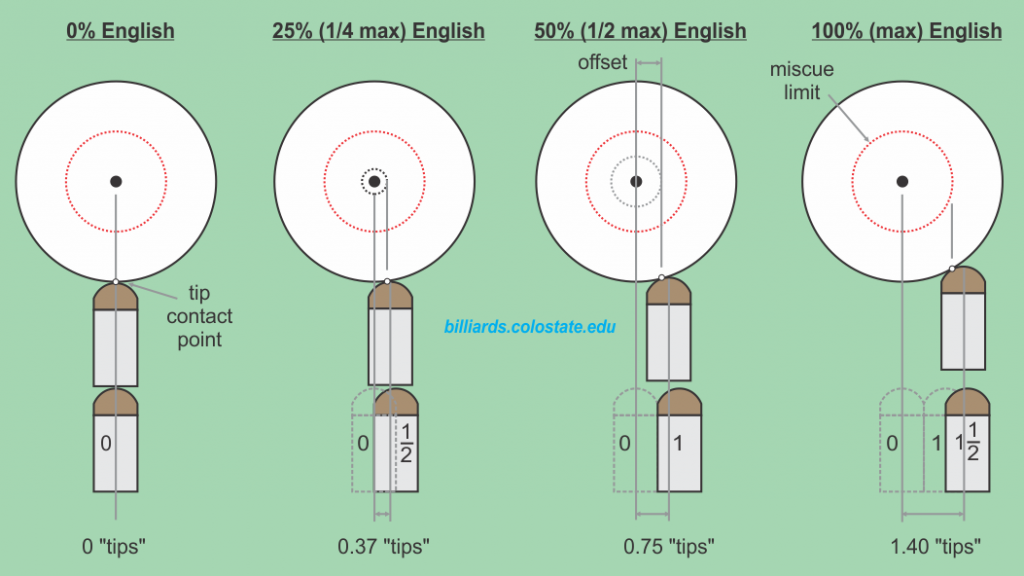
Some people interpret “tips of spin” to actually mean half “tips of spin.” For them, “1 tip” corresponds to shifting the cue half of the tip’s width (from the center of the tip to the edge). Using this scheme, the number of “tips” for the tip size and shape in the diagram above would actually be 0 for 0%, about 3/4 (2 * 0.37) for 25%, 1 1/2 (2 * 0.75) for 50%, and almost 3 (2 * 1.40) for 100%. Below is an illustration of the two common definitions of “tips:”
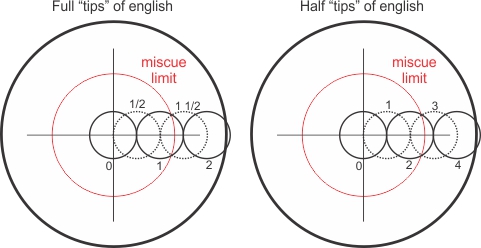
Here is a good illustration from Patrick Johnson (in AZB post) of how half “tips” relate to thirds of maximum sidespin. The actual chalk mark (or “contact patch”) on the CB for each tip position is shown with the small dark-blue circle. As described and illustrated below, each 1/3 of maximum spin corresponds to about 1 diamond of rebound-angle change across the table with a kick straight into a side cushion.
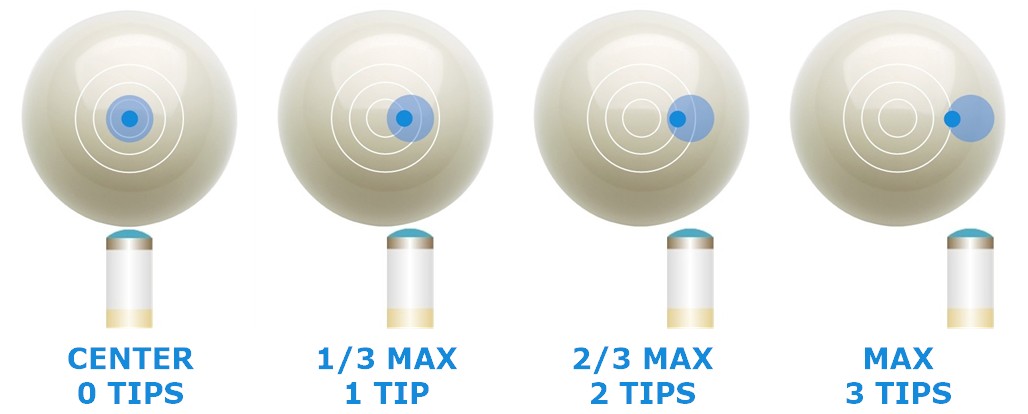
Some people interpret “tips of spin” to actually mean “chalk marks.” Here’s a photo from an AZB post by iusedtoberich showing chalk marks (the round shape a chalked tip leaves on the CB after a hit):
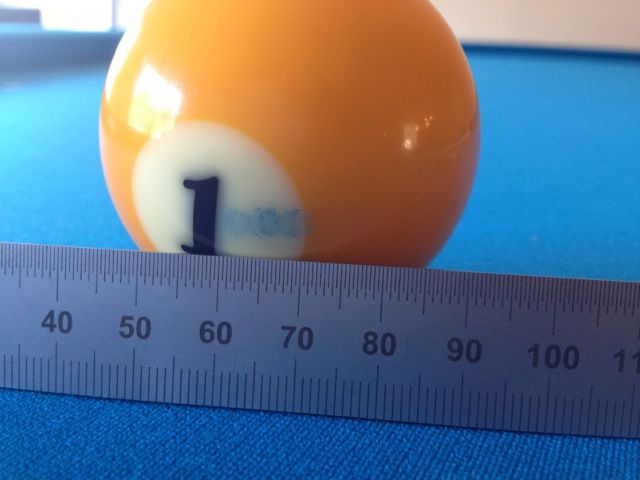
Chalk mark (or “contact patch”) size varies with tip hardness and shape, and with shot speed (see TP B.22), but the average size is about 5/32″ or 4 mm. Maximum spin is about 3 to 4 “chalk marks” or “contact patches.”
A “tip of spin” is also sometimes interpreted to mean “the amount of sidespin that creates one diamond of angle change across the table” (i.e., one “diamond” of spin) for a reference cut shot; however, this will vary with the type of shot, the angle into the cushion, and table conditions. The clock system is example of this interpretation:
Here’s a photo from an AZB post by Patrick Johnson illustrating this interpretation for cross-table kicks, where each 1/3 of maximum spin corresponds to about 1 diamond of rebound-angle change across the table with a kick straight into a side cushion:
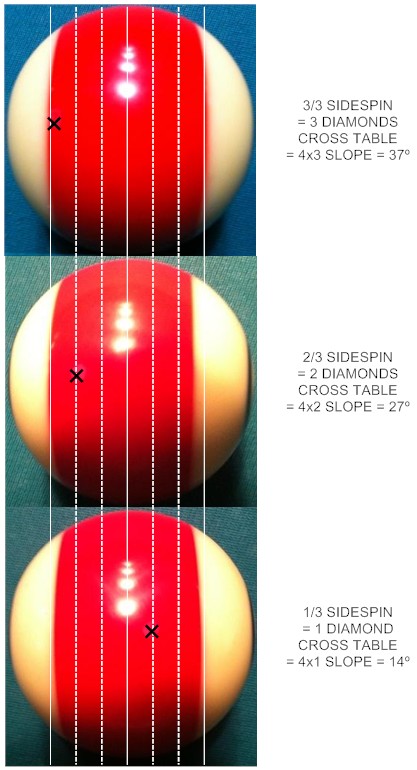
Obviously, it requires lots of feel and experience to know what tip position is required for each shot to create the amount of sidespin needed (e.g., to create the desired rebound angle change off a cushion). However, it is helpful to be able to communicate this amount to others in a clear and meaningful way. Clearly, based on the various common interpretations above, “tips” means too many radically-different things to too many people to be useful. A qualitative or percentage scale is much more meaningful. For example:
- a touch of spin (0-10%)
- a small amount of spin (10-30%)
- a medium amount of spin (30-60%)
- a large amount of spin (60-90%)
- near maximum spin, close to the miscue limit (90-100%)
from Patrick Johnson (in AZB post):
The scale drawing below shows an overhead view of three cues hitting three cue balls at different offsets – cue moved 1/4″, 1/2″ and 3/4″ to the left. Just for fun, it also compares where nickel and dime shaped tips contact the CB at those offsets, assuming the cue’s centerline is offset the same amount.
I notice two interesting things:
1. These three very common tip offsets – often called 1, 2 & 3 (or 1/2, 1 and 1 1/2) “tips” – produce almost exactly 1/3, 2/3 and 3/3 of maximum sidespin (the red lines on the CB), which correspond to 1, 2 and 3 diamonds of cross-table angle change. I just find this correspondence remarkably convenient.
2. The difference in contact points for nickel and dime shaped tips (shown by the circles at the cues’ tips and the lines connecting their centers with the CB’s center) is almost nonexistent: 1/128″ at 1/3 max sidespin, 1/64″ at 2/3 max sidespin and less than 1/32″ at maximum sidespin (true for nickel and dime tips of any width). So how true is it really that a dime shaped tip can produce noticeably more spin for the same tip offset?
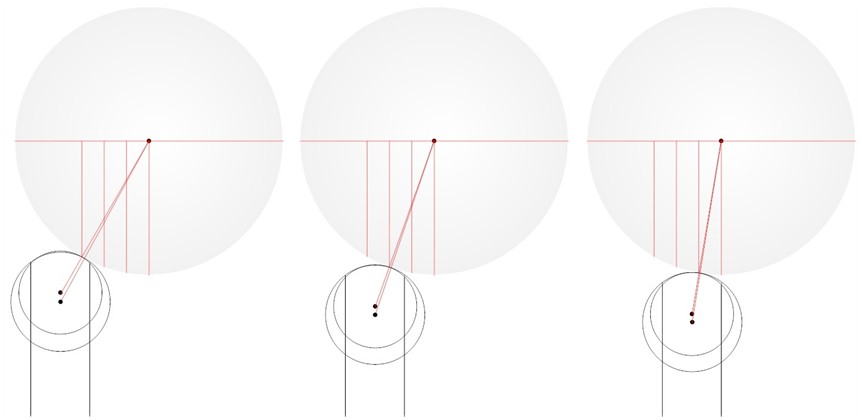
Center-of-Tip Spin Calibration (from Patrick Johnson via e-mail):
– Measure all side spin by where you point the center of your tip.
– Visualize the “center-of-tip” spin range from center ball to 2/3 the distance to the ball’s edge (vs. the “contact point” spin range of 1/2 the distance).
– Aim the center of the tip at the fraction of the larger spin range that corresponds to the fraction of maximum spin you want.
See the diagram below, where:
– the green hash marks are thirds of maximum side spin (where the stick’s centerline is aimed)
– the red “x”s are fourths of maximum side spin (where the tip actually contacts the CB)Because of the curvatures of the cue ball and the cue tip, the cue stick’s centerline must always be aimed a little farther from the cue ball’s center than the spot you want to hit.
To hit the CB precisely on the points that produce fourths of maximum side spin, aim your cue’s centerline at the corresponding thirds of maximum.
AIM = HIT
1/3 = 1/4
2/3 = 1/2
3/3 = 3/4
4/3 = 4/4This works because a typical tip’s radius is (the curvature of a nickel or dime) is about 1/3 the radius of a cue ball, so the tip’s center is always 1 1/3 x the contact point distance from center CB. Put another way, the contact point for any tip position is always 1/4 the distance from tip center to CB center. This geometric principle depends solely on the radius of the tip’s curvature, so it’s the same for all tip widths.
